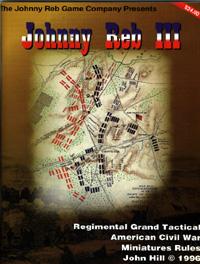|
|
|||||||||||||||
|
|
|||||||||||||||
 |
|||||||||||||||
 |
|
What’s Cooking? Johnny Reb III is the latest incarnation of the Johnny Reb gaming system. Designed by John Hill, it is a well known and well supported set of rules for the ACW. It features simultaneous movement and a strong command-and-control element with each unit being given orders each turn (orders are marked with counters). The rules have an experimental organization. They are separated into six sections based on most common usage. Since players will need to refer to infantry rules most, these comprise the first section, followed by Artillery, Morale, Command & Control, Resolving Charges and Cavalry (plus a few short chapters on terrain and the like).
List Of Ingredients Johnny Reb III is a staple-bound 96 page booklet. Included with the rules are four identical reference cards and a sheet of die-cut counters used to indicate unit orders, morale status, etc. Of the 96 pages, the final 24 are advertising. There are no scenarios or army lists included in the rules, but they are available separately. How Big? How Many? How Long? In JR3 one turn represents 20 minutes. The ground scale is 1” = 50 yards and each figure represents 30 men. Since JR3 is designed specifically for 15 mm figures, players using other size figures will need to convert all scales (a chart is included for most figure sizes from 5 mm up to 25 mm). Basing, Braising, and Roasting: How To
The rules state that exact basing size is not critical, so long as each side is based similarly. However, the basing provided for 15 mm figures is: While casualties are measured in figures, they are marked with bits of pipe-cleaner (the color of which also acts to indicate morale status). Which Comes First, Cheese or Salad?
Strangely, the turn sequence is presented half way through the rules on page 33. Each turn consist of nine phases: The Gourmet Touch With the exception of charges, Johnny Reb III’s core mechanics are complex versions of other well known mechanics. Fire combat, for example, is resolved cross indexing the dice with firing strength. However, the number of dice rolled varies, and there are a large number of modifiers both to the die roll and to the number of dice thrown. Fire Combat: Both artillery fire and infantry fire are resolved in the same way. One counts the number of figures firing and cross index this with the roll of one or more dice. For example, units with “Hold” orders throw 3 dice. Dice are added or subtracted for morale, range, number of previous volleys in the phase, etc. There are also modifiers to the dice roll itself, for enfilades, works, green troops, terrain, etc. There are also rules for penetration - basically, units behind the target may also take casualties. While there are a lot of modifiers, I suspect they would quickly become memorized. In any case, they are summarized on the player aid cards included. There are additional rules which cover skirmishers, sharpshooters, ammunition, etc. Charges: Charges are a major part of Johnny Reb II, and are both subtle and complex. The rules for the Resolve Charges phase of the game turn takes 9 full pages to explain! That said, however, the rules seem (to the untrained eye) pretty comprehensive. There are two types of charges - coordinated and (obviously) uncoordinated. While complex in the execution, this really does call out the difference between two regiments attacking as a single unit, as opposed to two piece-meal attacks by two separate units. Not all 2:1 odds are created equal! Briefly (and possibly inexactly) charging units reveal their targets. Attacking units then suffer disorder (based on a variety of factors). Defenders take defensive fire and possibly counter-charges. Both players then “Dice Down for Impact.” Essentially each charge includes three sources of combat results: defensive fire and counter-charges; impact; and melee. After defensive fire impact is just that - does either side throw the other back? If the attacker throws the defender back, and has enough movement to remain in contact melee follows, otherwise each side makes an “end-of-charge” volley. Command-And-Control: The C-n-C rules are orders oriented. Each turn, every unit is given an order. Units may be too far from their commander to receive orders, in which case they may not advance or charge. Other conditions, such as losses or shaken morale, may prohibit the issuing of certain orders to certain units. Morale: In JR3 each unit has a basic morale. Over time this may be eroded, due to casualties, cover, leadership etc. Essentially as morale erodes, the unit becomes less and less effective. This is simulated through “Tactical Competence.” In essence, for a variety of actions, units must check their morale. Morale checks are fairly simple: on two dice, roll higher than your modified morale to pass. If they fail the morale check they do not fully complete the action as intended. A raw “2” is an instant rout and a raw “12” is an instant rally. Of course, units also check morale for other reasons, such as their first casualty; for every stand removed; if a visible unit within 6” routs, etc. The Good, the Bad, and the Incomprehensible:
There’s no nice way to say this: the organization and layout of the rules is just dreadful. The breakdown by “most common use” is just not a good way to organize a rules book - save that for the player aids. Each section begins with the major charts for that section. However, most of what is on the chart remains unexplained. For example, at the start of the Infantry Section we are shown a chart about Formations & Movement (page 5). A note explains that one column gives a value used in “Impact Dice Down.” This is not defined on this page. Nor does it tell you where it is defined. Checking the index, we see it listed on quite a few pages. The first definition of Impact Dice Down is found in a chart on page 37 in the section on Sequence of Play. Worse still page 37 is not one of the pages identified in the index. It turns out this is explained fully in Step Four of Charge Resolution, on page 49. I assume you can imagine how frustrating reading a rules book like this might be. Finally Impact Dice Down is also called “Dice Down for Impact.” I could cite plenty more examples, but you get the point. I think this strange method of organizing the rules also affected the quality of the writing. Many of the “rules” section feel like lists of modifiers and exceptions to rules. For example, consider infantry movement. On page 8 the complete “General Movement Rules” appear as a bulleted list: That is the complete list. Granted there are further movement rules in the sequence of play section. But where are the rules? Of these 6 bullets, two refer only to charges (shouldn’t that be in the Resolve Charges” section?). What if, of my four stands, only one goes in the woods? Do all stands have to pay the penalty? Can I save movement from turn to turn? Can a regiment give its movement to another? I know, obvious enough to experienced gamers, but I don’t think any set of professionally published rules should exclude such basic material. On the positive side: the rules are very well illustrated and have plenty of extended examples. So even if you don’t understand every term for, say, firing, you at least have good solid examples to follow along with as you find your way. Fortunately the player aid cards are fairly complete, easy to understand (once you get the rules) and nicely presented. I get the feeling that if you had experienced players to teach you, the player aid card is all you’d really need. In sum, best to learn with a group of experienced players. Failing that, start by reading the sequence of play, and be prepared to have to slog through at least two or three times before it all ”comes together.” Or even better, print off some cardboard bases for a couple regiments and run a solo turn or two (of course, if you have figures already, use those, however they may be based). Where to Get Help If the Smoke Alarm Goes Off
Home Page: The home page is hosted by Grandiosity here. Support: The Yahoo group for Johnny Reb 3 is very active. You will need to register with Yahoo (it’s free). Links & Resources: |
 |
|||
|
|
|||
